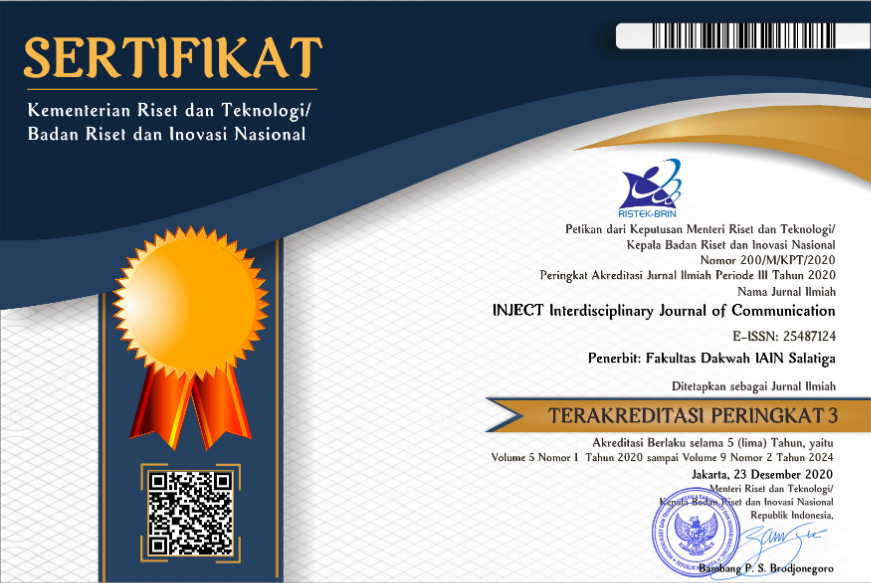How To Communicate Islam Via New Media? Some Lessons From The Quraish Shihab Podcast
Abstract
This article aims to answer how to communicate Islam through new media. Methodologically, this study is a ethnographic study that focuses on the Quraish Shihab Podcast channel. This study shows several findings; first, Islam must be communicated in a rational (logical) language. Second, Islamic communication must be considering the condition of the people being preached. Third, Islamic communication provides an alternative by providing various options and not forcing the message recipient. Fourth, communication via new media is substantive by basing each message on a deep understanding of the themes discussed. Fifth, Islamic communication must be humanistic, by prioritizing Islamic universal messages. These findings imply that the Islamic communication practices in the public space of new media must be able to create a peaceful space, encourage progress, strengthen culture and civilization, and facilitate good relations with others.
Keywords
Full Text:
PDFReferences
Adeni. (2020). Online Religion And Rethinking The Da’wah Authority Toward An Inclusive Da’wah: A Conceptual Study. 21(1), 111–135. https://doi.org/10.14421/JD.2112020.4
Adeni, A., & Bakti, A. F. (2020). Reconceptualising the Elements of Islamic Propagation: Religious Response and Adaptation to New Media. Jurnal Komunikasi Islam, 10(2), 198–216.
Adeni, A., Koroglu, O., & Hasanah, S. (2022). Combining old and new media for Islamic da’wa activity: The Case of Indonesian Nursi movement. Jurnal Ilmu Dakwah, 42(1), 131–143.
Bauwens, M. (1996). Spirituality and technology: Exploring the relationship. First Monday.
Branston, G., & Stafford, R. (2010). The media student’s book. Routledge.
Brasher, B. (2001). Give me that online religion. Unknown Publisher.
Campbell, J. (2002). Reference and consciousness. Clarendon Press.
Campbell, R., Martin, C. R., & Fabos, B. (2011). Media and culture: An introduction to mass communication. Macmillan.
Dawson, L. L. (2000). Researching religion in cyberspace: Issues and strategies. Religion on the Internet, 25–54.
Eickelman, D. F., Anderson, J. W., & Tessler, M. (2003). New media in the Muslim world: The emerging public sphere. Indiana University Press.
Fenton, N. (2010). NGOs, new media and the mainstream news: News from everywhere. New Media, Old News: Journalism & Democracy in the Digital Age, 153–168.
Green, N., & Haddon, L. (2009). Mobile communications: An introduction to new media. Berg.
Helland, C. (2000). Online-religion/religion-online and virtual communitas. Religion on the Internet, 205–224.
Højsgaard, M. T. (2005). Cyber-religion: On the cutting edge between the virtual and the real. In Religion and cyberspace (pp. 50–63). Routledge.
Holmes, D. (2012). Teori komunikasi: Media, teknologi, dan masyarakat. Yogyakarta: Pustaka Pelajar, 33.
Koroglu, O., & Tingoy, O. (2011). Principles of Islamic Communication: A Comparison with Western Communication Approaches and Some Turkish Examples. World Congress on Islamic Systems (World-ISLAM2011).
Levy, P. (1997). Cyberculture. Editions du Conseil de l ‘Europe. Paris: Editions Odile Jacob.
Mowlana, H. (2007). Theoretical perspectives on Islam and communication. In The global intercultural communication reader (pp. 303–316). Routledge.
Mubasyaroh, M. (2016). Da’Wah Model of Prophet Muhammad in Madina. QIJIS (Qudus International Journal of Islamic Studies), 2(1), 47–62.
Poster, M. (1995). Postmodern virtualities: In the second media age. Cambridge, UK: Polity Press. Retrieved June, 28, 2003.
Ravault, R. J. J. (1980). Some Possible Economic Dysfunctions Of The Anglo-American Practice Of International Communications.(A Theoretical Approach). The University of Iowa.
Thayer, L. O. (1968). Communication and communication systems in organization, management, and interpersonal relations.
Zamhari, A., Han, M. I., & Zulkifli, Z. (2021). Traditional Religious Authorities in New Media: Cariustadz. Id Platform as An Alternative Cyber Fatwa and Da’wah Media among the Middle-Class Urban Muslims. AHKAM: Jurnal Ilmu Syariah, 21(1).
DOI: https://doi.org/10.18326/inject.v7i2.%25p
Refbacks
- There are currently no refbacks.
Copyright (c) 2022 Adeni Adeni

This work is licensed under a Creative Commons Attribution 4.0 International License.









